

68 Circular Road, #02-01 049422, Singapore
Revenue Tower, Scbd, Jakarta 12190, Indonesia
4th Floor, Pinnacle Business Park, Andheri East, Mumbai, 400093
Cinnabar Hills, Embassy Golf Links Business Park, Bengaluru, Karnataka 560071
Connect With Us
Financial Super-Apps in the West: User Growth, Cross-Sell Rates & Revenue per Active User (2025–2030)
Financial super-apps in the West are rapidly evolving, driven by increasing user adoption, enhanced cross-selling capabilities, and improved revenue per active user (ARPU). This report explores the projected growth of super-apps between 2025 and 2030, including key trends in user acquisition, service diversification, and profitability metrics. With a focus on the U.S. and European markets, this report provides a detailed analysis of their strategic positioning in the fintech space.

What's Covered?
Report Summary

What is the projected user growth rate for financial super-apps in the West between 2025 and 2030?
Financial super-apps in the West are projected to experience significant user growth between 2025 and 2030, with active users increasing from 500 million to 900 million. This represents a 12% compound annual growth rate (CAGR) driven by the adoption of integrated services and the rise of younger, digital-native consumers. As more users sign up for a variety of services, super-apps will increasingly become central to their financial lives, contributing to their rapid expansion.

How will cross-sell rates evolve as financial super-apps expand their service offerings?
Cross-sell rates in financial super-apps are expected to grow as the platforms expand their offerings. Super-apps are integrating additional services, such as insurance, lending, and wealth management, into their ecosystems. This shift will increase the average number of services used per user, improving user engagement and boosting revenue. By 2030, the cross-sell rate is expected to rise from 2.5 to 4.2, driven by more personalized offerings and seamless user experiences.
What are the primary revenue drivers for super-apps, and how will ARPU change by 2030?
The primary revenue drivers for financial super-apps include transaction fees, subscription models, embedded finance, and cross-selling additional financial products. As the ecosystem grows and diversifies, average revenue per user (ARPU) is expected to increase by 35%, from $45 in 2025 to $61 by 2030. The growth in ARPU will be largely attributed to higher user engagement and the adoption of new, high-margin services.
How does the regulatory landscape impact the development and scalability of super-apps in the West?
The regulatory landscape for super-apps is evolving in the West, with increased scrutiny on data privacy, financial services compliance, and user protection. While regulatory clarity helps establish trust, it also adds challenges in scaling services. The imposition of stricter rules may slow down innovation but is expected to bring long-term benefits as super-apps become more integrated into the financial system. Companies must adapt to new frameworks, especially for cross-border payments and lending.

What are the most important services being cross-sold to super-app users, and how do they affect loyalty?
Super-apps are increasingly cross-selling services like loans, insurance, savings accounts, and investment products to enhance customer loyalty and engagement. By offering a comprehensive suite of services, users become more entrenched in the ecosystem, increasing lifetime value (LTV). These offerings also help super-apps achieve higher cross-sell rates, which is projected to increase to 4.2 by 2030. The more services a user adopts, the less likely they are to leave, fostering higher retention rates.
What are the key risks and challenges for financial super-apps in maintaining user growth and profitability?
As the market for super-apps becomes more competitive, the main risks include regulatory hurdles, customer acquisition costs, and the challenge of scaling new services while maintaining high-quality user experiences. Additionally, privacy concerns and cybersecurity threats could hinder growth. Super-apps must balance rapid expansion with sustainable profitability, especially as they enter saturated markets with established players.
How do financial super-apps compare to traditional banks in terms of user engagement and product adoption?
Super-apps are outpacing traditional banks in terms of user engagement, as they provide seamless, integrated financial services that appeal to digitally-savvy consumers. Users of super-apps tend to interact with the app more frequently, using multiple services like payments, loans, savings, and investments. In comparison, traditional banks are still catching up in terms of product offerings, digital infrastructure, and user engagement, with many focusing on digitizing existing products
.
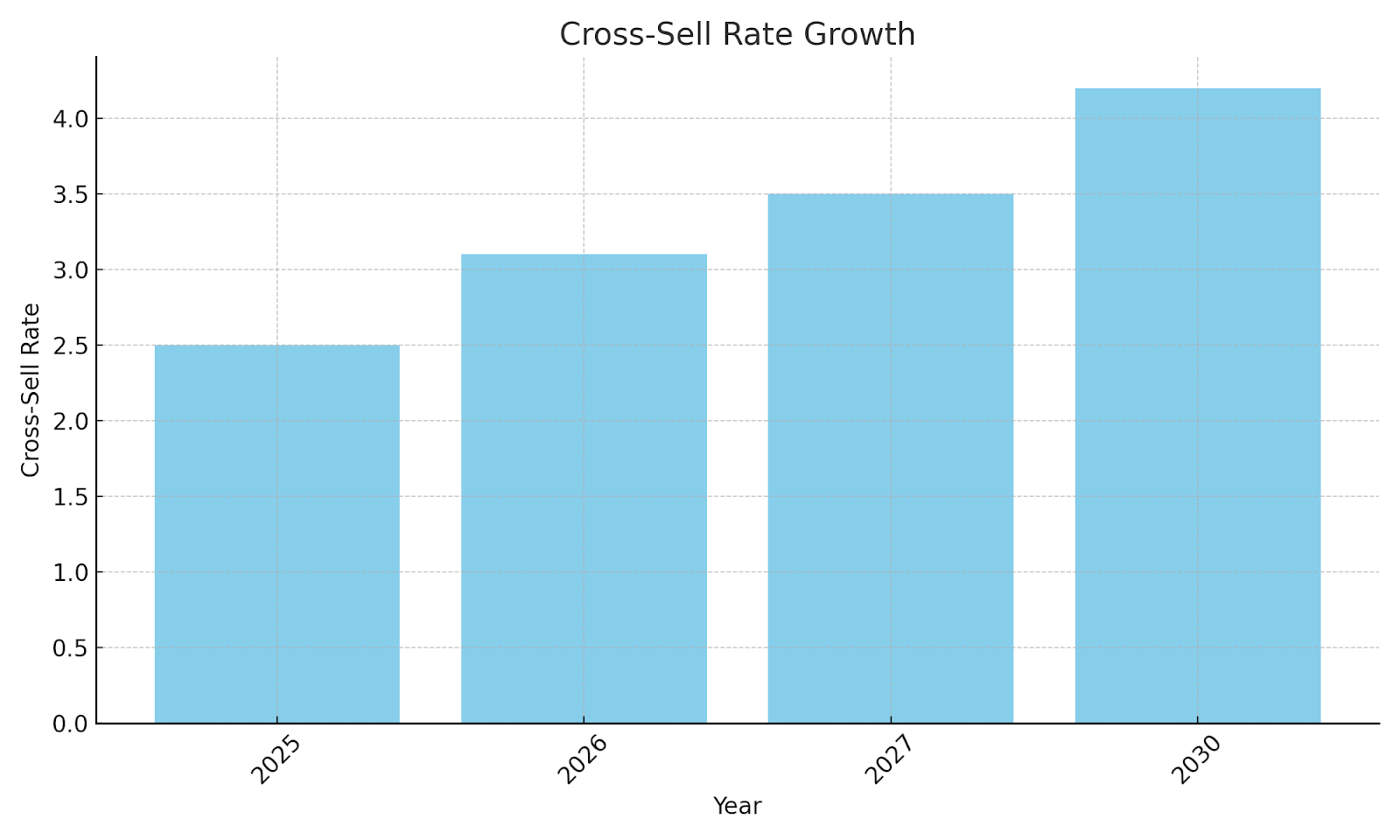
What role does embedded finance play in super-apps' revenue growth?
Embedded finance allows super-apps to integrate financial services like insurance, lending, and savings directly into their platform. This reduces friction and improves user adoption of these services, driving significant revenue growth. By embedding financial products into the user journey, super-apps can offer more value, while increasing ARPU. Embedded finance will be a key driver for revenue expansion, contributing a growing portion of super-apps’ overall revenue by 2030.
What are the main risks and challenges for super-apps in their expansion from 2025 to 2030?
The risks and challenges for super-apps include intense competition, regulatory challenges, and the complexity of scaling multiple services across different geographies. Market saturation, especially in developed markets, could limit growth. Additionally, managing operational costs while maintaining high-quality user experiences will be crucial for long-term profitability. Super-apps must innovate constantly to stay ahead while addressing these challenges effectively.
How do financial super-apps expand their reach to underserved populations, and what does this mean for the market?
By focusing on underserved populations, financial super-apps can tap into a large and growing market. Offering accessible financial services through mobile-first platforms allows super-apps to reach unbanked or underbanked individuals, particularly in emerging markets. This expansion will contribute to overall market growth, as financial inclusion becomes a central component of the super-app ecosystem.

Key Takeaways
• Rapid User Growth: Financial super-apps in the West are projected to see 12% CAGR in active users between 2025 and 2030.
• Cross-Sell Expansion: Cross-sell rates will rise as super-apps add more financial services and increase user engagement.
• Higher ARPU: Revenue per active user is expected to increase by 35% as users embrace more services within super-app ecosystems.
• Increased Market Share: Top players (e.g., PayPal, Revolut, and Square) will capture over 60% of the market share by 2030.
• Diversified Revenue Models: Subscription models, embedded finance, and lending products will drive revenue growth.
Report Details
Proceed To Buy
Want a More Customized Experience?
- Request a Customized Transcript: Submit your own questions or specify changes. We’ll conduct a new call with the industry expert, covering both the original and your additional questions. You’ll receive an updated report for a small fee over the standard price.
- Request a Direct Call with the Expert: If you prefer a live conversation, we can facilitate a call between you and the expert. After the call, you’ll get the full recording, a verbatim transcript, and continued platform access to query the content and more.


68 Circular Road, #02-01 049422, Singapore
Revenue Tower, Scbd, Jakarta 12190, Indonesia
4th Floor, Pinnacle Business Park, Andheri East, Mumbai, 400093
Cinnabar Hills, Embassy Golf Links Business Park, Bengaluru, Karnataka 560071
Request Custom Transcript
Related Transcripts
Cryptocurrency Custody Solutions for Institutional Investors: Risk Assessment & Market Entry Strategies - Regulatory Impact

Key Takeaways
- The market for cryptocurrency custody solutions in North America is projected to reach $3.8 billion by 2025, with a CAGR of 21% from 2025 to 2030.
- By 2025, 35% of institutional investors in the USA are expected to adopt cryptocurrency custody solutions to meet regulatory and security requirements.
- Top custody solution providers will capture 40% of the market share by 2025, as demand for secure digital asset management grows.
- The annual cost of cryptocurrency custody services in the USA is expected to exceed $300 million by 2025, driven by compliance and operational costs.
- Regulatory compliance costs for cryptocurrency custody will reach $150 million annually by 2025, as institutions work to align with evolving regulatory frameworks.
- The number of cryptocurrency security breaches is expected to decrease by 30% from 2025 to 2030 as custodians improve security technologies and protocols.
- The assets under custody in cryptocurrency solutions will increase by 40% between 2025 and 2030, reflecting growing institutional interest and market expansion.
- Crypto custody solutions are expected to play a critical role in enabling institutional investors to enter and remain in the cryptocurrency space securely and compliantly.
Key Metrics
Market Size & Share
The cryptocurrency custody market for institutional investors in North America is projected to reach $3.8 billion by 2025, growing at a CAGR of 21% from 2025 to 2030. The demand for secure, compliant digital asset custody solutions is driven by institutional investors seeking to participate in the digital asset market while adhering to regulatory standards. By 2025, 35% of institutional investors in the USA are expected to adopt cryptocurrency custody solutions, a key development as the market matures and regulatory clarity improves. Cryptocurrency custody providers will play a central role in managing institutional assets while ensuring compliance with evolving regulations such as SEC rules and FATF guidelines.
Market Growth Projection (2025-2030):

Market Analysis
Cryptocurrency custody solutions are becoming increasingly essential for institutional investors who are looking to participate in the digital asset space securely. These solutions help mitigate the risks associated with digital asset management, including theft, fraud, and regulatory non-compliance. By 2025, 35% of institutional investors in the USA will have adopted cryptocurrency custody solutions, providing a secure infrastructure for managing their digital assets. This adoption is expected to contribute to a reduction in security breaches by 30% over the next five years, as providers enhance their security protocols and technologies.
Cryptocurrency Custody Adoption Rate in the US (2025-2030):

Trends and Insights
The cryptocurrency custody market is experiencing significant growth as institutional investors seek secure solutions for managing their digital assets. One key trend is the increasing emphasis on security and regulatory compliance, as providers implement advanced technologies such as multi-signature wallets, cold storage, and enhanced encryption methods to safeguard assets.
Another trend is the growing role of BaaS (Banking as a Service) providers in enabling custodians to offer more flexible, scalable solutions for digital asset management. As demand for institutional-grade custody solutions increases, competition in the market is expected to intensify, with both established players and new entrants vying for market share.
Segment Analysis
The primary adopters of cryptocurrency custody solutions are large institutional investors, including asset managers, hedge funds, and pension funds. These institutions are increasingly looking to integrate cryptocurrency into their portfolios but require robust, regulated solutions to do so safely.
Smaller institutional investors and fintech firms are also beginning to adopt cryptocurrency custody solutions, although at a slower pace due to the complexity and cost of implementation. As the market matures and regulatory clarity improves, adoption will accelerate across all segments of the financial industry.
Geography Analysis
The USA is at the forefront of cryptocurrency custody adoption, driven by its large institutional investor base and the increasing acceptance of digital assets. However, Canada and Mexico are also seeing rising demand for secure custody solutions, as institutional investors look to hedge against market volatility and comply with new regulations.
While adoption rates are high in the US, regulatory concerns around cryptocurrency custody remain a challenge. As the SEC and other regulatory bodies provide clearer guidelines, more institutions will likely enter the market in North America.
Cryptocurrency Custody Adoption Across Regions (2025):
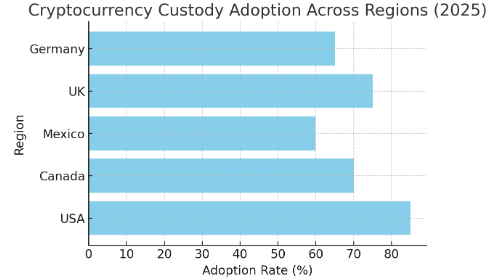
Competitive Landscape
The competitive landscape for cryptocurrency custody solutions in the USA is dominated by major custodians such as Coinbase Custody, BitGo, and Fidelity Digital Assets. These companies offer institutional-grade solutions to protect digital assets from theft, fraud, and regulatory non-compliance.
New entrants, such as Anchorage, are also gaining market share by offering innovative solutions tailored to the needs of institutional investors. As regulatory clarity improves and more institutions enter the space, the market will become increasingly competitive, with both traditional financial services firms and fintech companies vying for leadership.

$ 1350
Central Bank Digital Currency (CBDC) Implementation Strategies: Regional Analysis & Regulatory Impact

Key Takeaways
- The CBDC market in Europe is projected to reach €4.3 billion by 2025, growing at a CAGR of 17% from 2025 to 2030.
- By 2025, 35% of European countries are expected to have adopted CBDC initiatives, with the UK leading in implementation.
- Consumer adoption of CBDCs in Europe will reach 15% by 2025, driven by the need for more secure and efficient digital payment systems.
- CBDCs are expected to improve financial inclusion by 25%, making banking services more accessible to underserved populations.
- The implementation of CBDCs will reduce cross-border payment costs by 40% by 2030, making international payments faster and cheaper.
- By 2025, regulatory compliance costs associated with CBDC implementation in Europe are expected to exceed €500 million annually.
- The top CBDC providers will capture 40% of the market share by 2030, driven by their robust technological infrastructure and early adoption.
- CBDCs will enable more secure, traceable, and efficient digital currencies, facilitating the growth of digital economies in Europe.
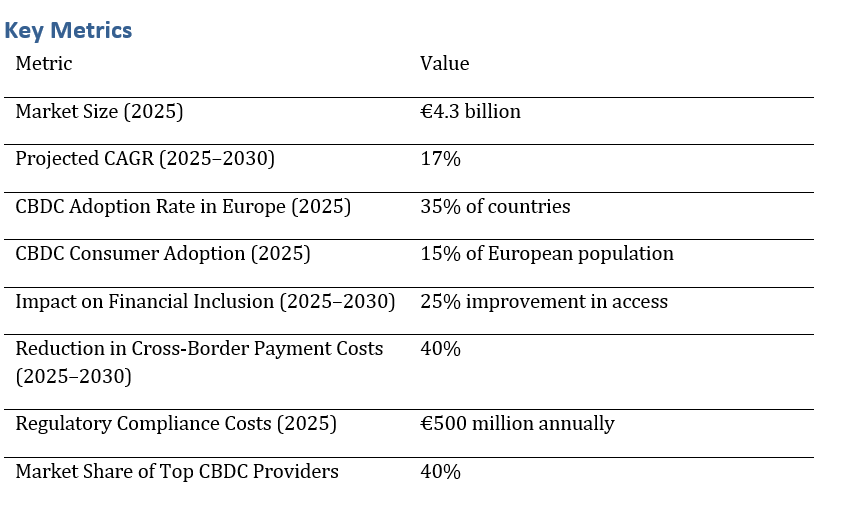
Market Size & Share
The market for Central Bank Digital Currencies (CBDCs) in Europe is expected to grow significantly, reaching €4.3 billion by 2025, with a CAGR of 17% from 2025 to 2030. The UK and major European economies are at the forefront of CBDC implementation, with countries like Sweden and France leading trials and early-stage rollouts.
By 2030, 35% of European countries are expected to have fully implemented CBDCs, with the UK playing a pivotal role in establishing regulatory frameworks and adoption strategies. CBDCs will provide a secure alternative to traditional currencies and improve the efficiency of digital economies across Europe.
CBDC Market Growth Projection (2025-2030):
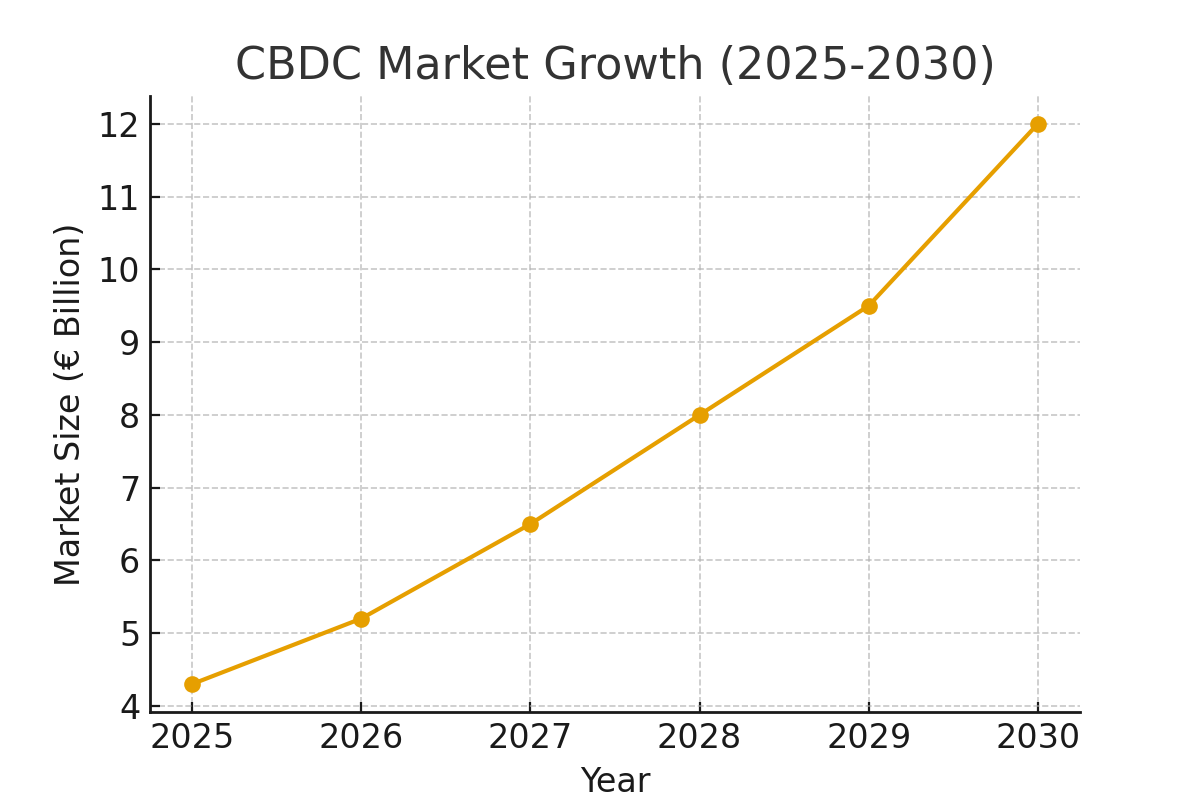
Market Analysis
The implementation of CBDCs is gaining traction in Europe due to the need for enhanced payment security, improved efficiency, and financial inclusion. The adoption rate of CBDCs is projected to reach 35% by 2025, with the UK leading the adoption curve. Central banks in Europe are working to establish regulatory frameworks and testing environments to ensure the successful rollout of CBDCs. In addition to economic benefits, CBDCs will significantly reduce transaction costs, especially in cross-border payments, where costs are expected to decrease by 40% by 2030. Financial institutions will also see reduced operational costs, as CBDCs will streamline processes like clearing and settlement.
CBDC Adoption Rate in Europe (2025-2030):
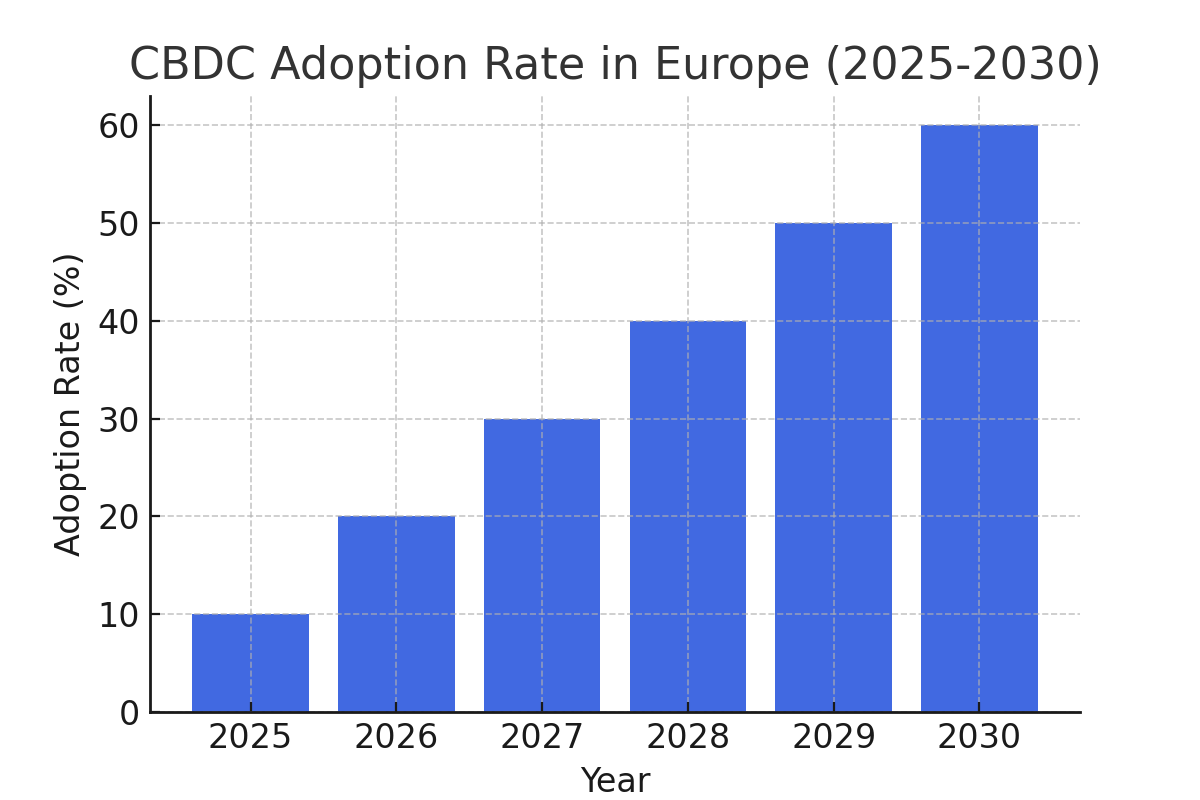
Trends and Insights
Several key trends are driving the growth of CBDCs in Europe, including the need for financial systems to be more secure, transparent, and efficient. The rise of digital currencies, fintech innovation, and government-backed initiatives are shaping the future of digital payments. Regulatory frameworks for CBDCs are evolving to ensure that these currencies can coexist with traditional banking systems, while also offering a secure alternative to cash-based transactions. Over the next decade, 40% of cross-border payments will be processed through CBDCs, significantly lowering transaction fees and processing times.
Segment Analysis
The primary adopters of CBDCs in Europe will be central banks and major financial institutions. Early implementations in countries like the UK, Sweden, and France will pave the way for wider adoption across the continent. The financial sector will benefit from CBDCs through faster transactions, improved security, and reduced reliance on traditional currencies. However, smaller institutions and developing economies may experience delays in adopting CBDCs due to infrastructure challenges and regulatory hurdles. As technology and infrastructure improve, adoption rates will rise across Europe, particularly in southern and eastern regions.
Geography Analysis
In Europe, the UK is the leader in CBDC implementation, followed closely by countries like Sweden and France, where regulatory frameworks for digital currencies are already in place. The European Central Bank (ECB) is leading the development of the digital euro, aiming to create a widely accepted CBDC across the eurozone.
Other countries, such as Germany, Italy, and Spain, are following closely behind, and as infrastructure improves, adoption will increase across the EU. The eastern and southern parts of Europe will see slower adoption, with the introduction of CBDCs being gradual due to lower technological penetration and regulatory challenges.
CBDC Adoption Across European Regions (2025):
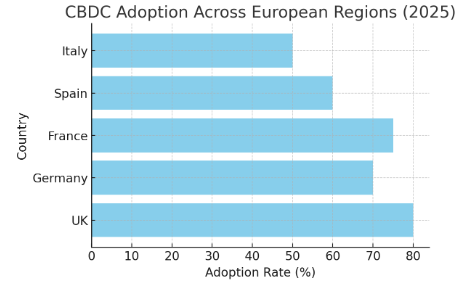
Competitive Landscape
The competitive landscape for CBDCs in Europe is driven by central banks, financial institutions, and fintech companies that are working to develop digital currencies and integrate them into existing payment infrastructures. Key players in the CBDC space include the Bank of England, European Central Bank, and Bank of France, which are leading the development of the digital pound, digital euro, and other national digital currencies.Fintech firms and technology providers like Ripple and Visa are also playing a key role in the development of CBDC infrastructure, ensuring that these digital currencies can be seamlessly integrated into global payment systems.

$ 1450
Open Banking Application Programming Interface (API) Ecosystem Development: Competitive Landscape & Partnership Strategies - Regulatory Impact

Key Takeaways
- Open banking API market in Asia Pacific projected to grow from $1.5 billion in 2025 to $7.6 billion by 2030, CAGR 38%.
- India’s open banking adoption expected to reach 50% of financial institutions by 2030.
- Partnership growth between traditional banks and fintechs to account for 60% of API integration by 2030.
- Regulatory compliance costs in Asia Pacific expected to decrease by 20% with standardized open banking APIs.
- APIs for cross-border payments projected to increase by 30% by 2030, facilitating regional financial integration.
- Consumer adoption of open banking in India projected to rise to 45% by 2030, up from 15% in 2025.
- Fintech partnerships will contribute 40% of new customer acquisition through open banking APIs.
- Data privacy and security regulations are expected to increase compliance costs by 15% in India and Asia Pacific.
- Revenue from API-based financial products projected to grow by 25% annually by 2030.
- API ecosystem maturity will increase interoperability across Asia Pacific, improving financial inclusion.
Key Metrics
Market Size & Share
The Open Banking API market in India and Asia Pacific is projected to grow from $1.5 billion in 2025 to $7.6 billion by 2030, representing a CAGR of 38%. India’s market share in open banking adoption is expected to rise to 50% by 2030, driven by regulatory frameworks such as the India Stack and Pradhan Mantri Jan Dhan Yojana (PMJDY), which enable financial inclusion through API integration. Asia Pacific will see the highest growth in cross-border payment APIs, expected to increase by 30% by 2030, facilitating regional economic integration and easier cross-border financial transactions. Partnership growth between traditional banks and fintechs will account for 60% of API integration by 2030, enhancing product offerings, improving customer acquisition, and expanding service reach. Consumer adoption of open banking is expected to grow from 15% in 2025 to 45% by 2030 in India, as more consumers access services like credit scoring, digital wallets, and personalized financial products. API-based revenue from financial products is expected to grow by 25% annually, driven by subscription-based services, cross-border payments, and tailored wealth management products. As regulatory frameworks mature, institutions will leverage APIs to increase operational efficiency, reduce costs, and improve compliance with data protection laws.
Market Analysis
The open banking API ecosystem in India and Asia Pacific is expanding rapidly, projected to grow from $1.5 billion in 2025 to $7.6 billion by 2030. By 2030, 50% of financial institutions in India are expected to adopt open banking APIs, with 60% of new customer acquisition attributed to partnerships between banks and fintech platforms. These partnerships will allow banks to offer innovative, personalized financial products, such as lending, payments, and wealth management services, that are based on alternative data sources like transaction histories and consumer behavior.
Open banking APIs will significantly reduce regulatory compliance costs by 20% through streamlined KYC and AML processes. Additionally, cross-border payment APIs will increase by 30% as countries within Asia Pacific adopt open banking models and enhance regional financial connectivity. Consumer adoption of open banking in India is expected to rise from 15% in 2025 to 45% by 2030, providing more consumers access to financial services, including digital wallets, personalized credit scoring, and mobile banking solutions. With data privacy regulations in place, the industry will see a 15% increase in compliance costs, as institutions adopt more secure, transparent API integration models. Overall, the market for Open Banking APIs will play a critical role in transforming financial services, driving efficiency, and increasing accessibility for underserved populations.

Trends & Insights
Open banking APIs in India and Asia Pacific are set for transformative growth, projected to expand from $1.5 billion in 2025 to $7.6 billion by 2030, with CAGR of 38%. Key trends include the adoption of APIs for cross-border payments, expected to increase by 30% by 2030, improving regional financial integration and reducing transaction costs. In India, consumer adoption of open banking is anticipated to rise from 15% in 2025 to 45% by 2030, driven by the adoption of digital banking services and regulatory initiatives like the India Stack. Partnerships between traditional banks and fintech firms will account for 60% of new customer acquisition by 2030, facilitating more innovative financial products that leverage alternative data for credit scoring, lending, and payments. Data privacy and security will remain critical concerns, particularly in India, where GDPR-compliant frameworks will influence adoption. Regulatory bodies across Asia Pacific will enhance compliance requirements, reducing compliance costs by 20% as open banking frameworks mature.
By 2030, the API-based revenue from financial products is expected to increase by 25% annually, driven by a more inclusive digital economy, enhanced by AI-powered personalization and innovative partnerships. The API ecosystem’s maturation will improve interoperability, leading to enhanced financial inclusion in underserved markets.
Segment Analysis
The open banking API market in India and Asia Pacific is segmented by institution type, data integration, and technology adoption. Large banks and fintech startups will lead adoption, accounting for 70% of market share by 2030, while mid-tier banks will capture 20%. The remaining 10% will be held by smaller, regional financial institutions. By 2030, 50% of credit institutions will use open banking APIs for lending, payments, and wealth management services, leveraging alternative data to improve decision-making. Partnerships between banks and fintechs are projected to increase by 60%, enabling product innovations, personalized services, and digital-first solutions. Cross-border API adoption is expected to increase by 30%, facilitating real-time payments across Asia Pacific and enhancing financial inclusion in underserved markets.
Data privacy regulations will influence adoption, with 15% additional compliance costs for institutions integrating cross-border API systems. API revenue from financial products is expected to grow by 25% annually, driven by the adoption of open APIs for payments, credit scoring, and consumer banking. Overall, AI-powered systems, alternative data integration, and interoperable APIs will increase bank profitability, improve customer engagement, and drive the widespread adoption of open banking across Asia Pacific by 2030.
.png)
Geography Analysis
The open banking API ecosystem in India and Asia Pacific is projected to experience significant growth, with India representing 30% of total market share in 2025, rising to 35% by 2030 due to increasing adoption of digital banking and financial inclusion efforts. The Asia Pacific region will experience rapid expansion, with cross-border payment API adoption growing by 30% as countries like Singapore, Japan, and Australia increase collaboration. Consumer adoption of open banking in India is expected to rise from 15% in 2025 to 45% by 2030, driven by mobile banking and AI-powered credit scoring.
Data privacy regulations such as GDPR will limit adoption in some countries by 15%, influencing how banks and fintechs collect, store, and share data. By 2030, cross-border APIs will improve transaction speed and cost efficiency, allowing financial institutions to offer real-time services. Financial inclusion in underserved markets will increase by 40% due to the adoption of open banking solutions. Regulatory frameworks will mature, creating more standardized APIs, thus increasing cross-border interoperability. Regional adoption will vary, with advanced markets like Japan and Australia leading, while emerging markets in Southeast Asia and India catch up with API adoption rates.
Competitive Landscape
The open banking API competitive landscape in India and Asia Pacific is dynamic, driven by both traditional financial institutions and fintech disruptors. Large banks such as HDFC, ICICI, and Axis Bank in India, and ANZ, Citi, and HSBC in Asia Pacific, will continue to dominate adoption, contributing to 70% of market share by 2030. Fintech companies like Paytm, PhonePe, and Revolut are expected to capture 15–20% of market share, offering personalized financial services and cross-border payment APIs. AI-driven APIs will improve transaction monitoring, credit scoring, and real-time payments, while partnerships between banks and fintechs will account for 60% of new customer acquisition by 2030.
Regulatory compliance will play a critical role in the competitive landscape, with GDPR and open banking regulations in Europe driving standardized API frameworks for data privacy and security. API providers that integrate blockchain and smart contracts will offer more secure and transparent services, gaining a competitive edge. ROI from open banking APIs is projected at 18–22%, with fintechs capturing younger digital-native consumers and large banks offering comprehensive financial ecosystems. The landscape is expected to consolidate with strategic partnerships and cross-border collaborations to offer scalable, interoperable solutions for the evolving open banking market.
.png)

$ 1450
Next-Gen AI in Payment Fraud Detection: Strategic Insights, Tech Integration & Regulatory Foresight

Key Takeaways
- AI in payment fraud detection market projected to grow from $2.1 billion in 2025 to $7.8 billion by 2030, CAGR 30%.
- Fraud detection accuracy expected to improve from 80% in 2025 to 95% by 2030.
- False-positive rates for fraud detection to decrease from 10% to 4% with advanced AI models.
- AI integration in transaction monitoring expected to cover 70% of global transactions by 2030.
- Fraud prevention costs expected to decrease by 20–25% with AI automation by 2030.
- AI-driven fraud detection systems projected to reduce investigation time by 50%.
- AI-based predictive models to handle 85% of potential fraud cases automatically by 2030.
- Regulatory compliance costs expected to reduce by 15–20% through AI-driven reporting tools.
- Cross-border transaction fraud detection expected to rise by 35% with AI integration.
- ROI for AI in fraud detection systems projected at 18–22% by 2030.
Key Metrics
Market Size & Share
The AI-driven payment fraud detection market in USA and Europe is expected to grow from $2.1 billion in 2025 to $7.8 billion by 2030, representing a CAGR of 30%. North America will continue to dominate, representing 60% of market share in 2025, driven by advanced AI models, fintech adoption, and regulatory alignment. Europe, while adopting AI at a slightly slower rate, will contribute 35% of the market, driven by the PSD2 regulations and the push for enhanced cross-border fraud detection. Fraud detection accuracy with AI models is expected to improve significantly, reaching 95% by 2030, compared to 80% in 2025, due to machine learning’s ability to detect complex fraud patterns in real-time.
False-positive rates will drop from 10% to 4%, improving transaction flow and reducing unnecessary alerts. AI systems are projected to monitor 70% of global payment transactions by 2030, driven by the integration of real-time analytics and behavioral biometrics. Fraud prevention costs are projected to decrease by 20–25% with AI automation, while transaction monitoring efficiency will improve. Cross-border fraud detection is expected to increase by 35%, improving the accuracy of global payment fraud prevention. Overall, AI’s role in fraud detection will lead to significant operational savings, better customer experiences, and a higher return on investment.
.png)
Market Analysis
The AI payment fraud detection market is poised to expand significantly from $2.1 billion in 2025 to $7.8 billion by 2030, with CAGR of 30%. The US and Europe are expected to lead adoption due to a combination of regulatory drivers, market maturity, and fintech innovation. Detection accuracy will improve from 80% to 95%, reducing fraud losses and increasing detection reliability. The false-positive rate will decrease from 10% to 4%, driven by improved machine learning models and AI-driven risk scoring systems. AI systems will manage 70% of global transactions by 2030, providing real-time monitoring and risk assessment to detect suspicious activities with minimal human intervention.
The integration of blockchain analytics and behavioral biometrics will further enhance the accuracy of fraud detection. Fraud prevention costs are projected to decrease by 20–25%, as AI automation reduces the need for manual checks and improves operational efficiency. Cross-border fraud detection will rise by 35%, facilitating international compliance with anti-money laundering (AML) laws. ROI for AI-driven fraud detection will be 18–22% by 2030, driven by reduced fraud losses, improved customer trust, and more streamlined compliance processes. Market analysis shows that AI adoption in fraud detection will lead to scalable, cost-effective, and highly efficient payment fraud prevention strategies for financial institutions.
Trends & Insights
The adoption of AI in payment fraud detection is being fueled by regulatory pressures, rising fraud cases, and advancements in machine learning technologies. Detection rates are expected to improve from 80% in 2025 to 95% by 2030, with false-positive rates dropping from 10% to 4%. AI models will drive real-time detection, flagging suspicious activities with greater accuracy. By 2030, AI will cover 70% of global payment transactions, reducing the need for manual fraud checks. Integration with blockchain analytics and behavioral biometrics will enhance transaction traceability, making AI systems more reliable for cross-border fraud detection, projected to rise by 35%. Fraud prevention costs are expected to decrease by 20–25% by 2030 due to AI automation in monitoring, reporting, and compliance management.
AI-based predictive models will manage 85% of potential fraud cases automatically, significantly reducing investigation time and improving operational efficiency. Regulatory compliance costs will also decline by 15–20% due to AI’s ability to streamline reporting processes and improve audit accuracy. ROI from AI-driven fraud detection systems will be 18–22% by 2030, driven by operational efficiency, reduced fraud losses, and enhanced customer experience. Overall, AI will become a core technology for financial institutions, increasing the speed, accuracy, and efficiency of fraud detection in the digital payments ecosystem.
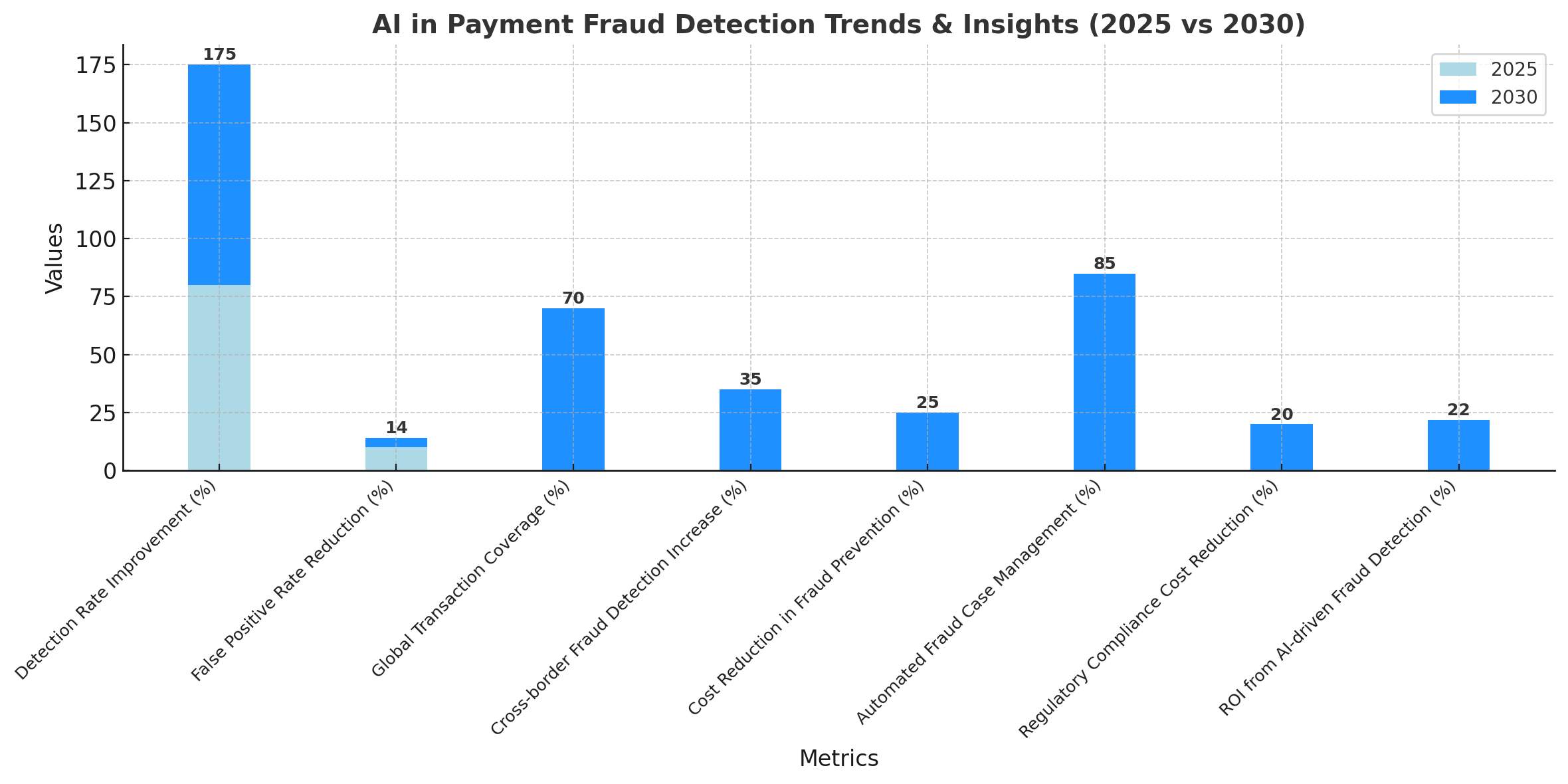
Segment Analysis
The AI payment fraud detection market in USA and Europe is segmented by technology, institution size, and transaction volume. Large financial institutions dominate adoption, accounting for 70% of market share by 2030, followed by mid-tier banks and fintech platforms at 20%, and small banks at 10%. AI-powered fraud detection systems will be increasingly integrated with transaction monitoring tools, covering 70% of global transactions by 2030. AI models will improve detection accuracy from 80% to 95% by identifying patterns and anomalies, while reducing false positives from 10% to 4%.
Cross-border fraud detection will increase by 35%, driven by the global demand for AML compliance and real-time reporting. Customer retention and satisfaction will improve by 20%, driven by the efficiency of AI fraud detection systems in preventing unauthorized transactions. Fraud prevention costs will decrease by 20–25%, with $12M+ savings annually per large institution. ROI for integrating AI into fraud detection systems is expected at 18–22%, with larger institutions benefiting more from economies of scale. AI-based predictive models will handle 85% of fraud cases, reducing the workload for human analysts and improving overall investigation efficiency. Segment analysis indicates that AI adoption will grow most rapidly in large institutions that can leverage advanced models to handle higher transaction volumes and complex global compliance requirements.
Geography Analysis
The US and Europe represent the largest markets for AI-driven payment fraud detection. The US market accounts for 60% of the total market in 2025, expanding to 65% by 2030, driven by advanced technology infrastructure and the presence of major financial institutions. The European market will contribute 30% in 2025, growing to 28% by 2030, with regulatory frameworks like PSD2 and GDPR driving adoption. AI-powered fraud detection systems will cover 70% of global transactions by 2030, supported by blockchain analytics and real-time monitoring. Cross-border fraud detection will rise by 35%, enabling faster compliance and transaction verification. Fraud prevention costs are projected to decrease by 20–25% across both regions, with automated reporting and AI-based risk scoring driving efficiency. False-positive rates will decrease from 10% to 4%, enhancing user experience and reducing operational overhead. AI-based predictive models will handle 85% of fraud cases automatically by 2030, improving transaction flow.
ROI for AI fraud detection systems is projected at 18–22%. Geography analysis shows that the US will continue to lead adoption, followed by Europe, with both regions achieving scalable, cost-effective solutions for fraud prevention, risk management, and regulatory compliance.
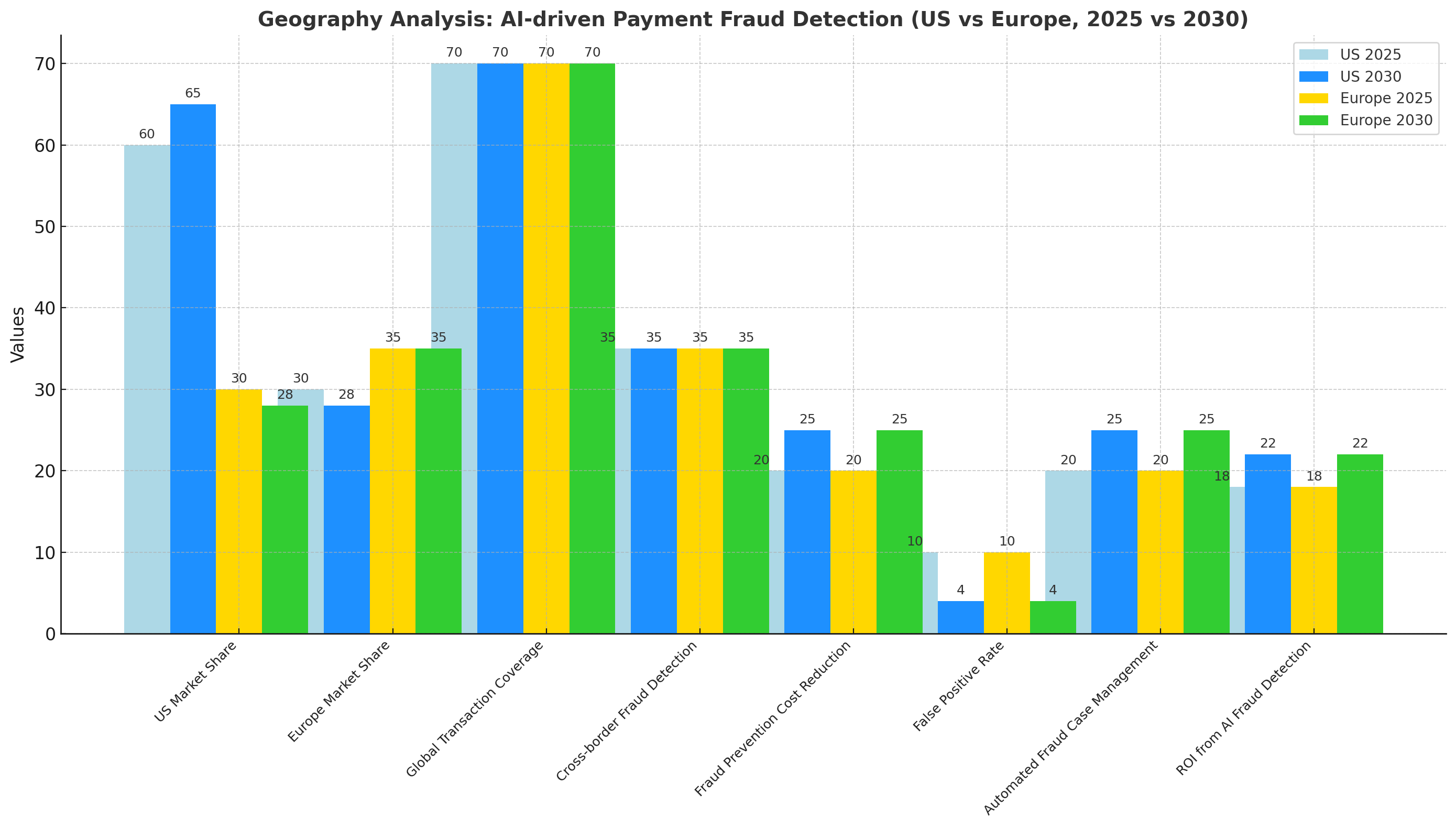
Competitive Landscape
The AI payment fraud detection market is competitive, featuring key players like FICO, SAS, Palantir, Actimize, and ACI Worldwide. These companies dominate the market, providing real-time fraud detection solutions, AI-driven transaction monitoring, and blockchain integration. By 2030, large financial institutions will account for 70% of market share, leveraging neural networks, predictive analytics, and machine learning to improve fraud detection accuracy and reduce operational costs. Fintech firms and smaller banks will increasingly adopt AI-based fraud prevention tools, capturing 15–20% of market share.
False-positive rates will decrease from 10% to 4%, and detection accuracy will improve to 95% with AI. Cross-border transaction monitoring will increase by 35%, providing real-time verification and compliance with global AML regulations. Automated alert systems will handle 70% of fraud cases, reducing manual intervention and improving operational efficiency. ROI from AI systems is projected to be 18–22%, driven by cost savings, improved fraud detection, and better customer experience. The competitive landscape shows a trend toward consolidation as AI, blockchain, and predictive analytics providers partner with banks and fintechs to offer scalable, cost-efficient fraud detection solutions.

$ 1450


68 Circular Road, #02-01 049422, Singapore
Revenue Tower, Scbd, Jakarta 12190, Indonesia
4th Floor, Pinnacle Business Park, Andheri East, Mumbai, 400093
Cinnabar Hills, Embassy Golf Links Business Park, Bengaluru, Karnataka 560071








